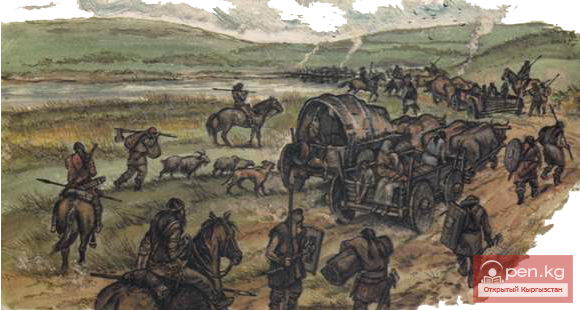In the ethnic composition of the Kyrgyz, tribes such as kurkureo, kuren, kalcha, keldike, kalmak, sart-kammak, kalmak-kyrgyz, chayu kazak, and others were represented, which, structurally, were not components of the aforementioned three branches. Historical information and genealogical traditions indicate that they belong to components of mixed or foreign origin (Abramzon, 1971. P. 26-28; 1960. P. 87-92; Alymbaeva, 1966. P. 200-212).
Large tribes within the right and left wings, as well as the internal union, in turn, branched out into numerous clans, the size of which was determined by the number of households (tutun).
The subdivision at the level of "children of one father" ("bir atanın baldary"), which is the lowest link of the clan organization, is characterized by its strength, ensured by blood ties and common economic interests. Its foundation consisted of family and kinship groups, which S.M. Abramzon referred to as the "living" form of clan organization among nomads (Abramzon, 1951. P. 152). Within the "children of one father," patriarchal-clan norms were strictly observed when resolving economic, social, and cultural issues, with the elder aksakal at the helm (Asanov, 2011. P. 197, 198). This level is characterized by joint productive activities and migration, as well as common territories. However, the need for collective organization of production within this framework did not always arise, but even with separate farming, internal connections remained stable. This was facilitated by spatial proximity, as "children of one father" tended to settle at a small distance from each other.
The next hierarchical community, "uruk," included closely related groups united based on a common genealogical tree. This taxonomic level, in turn, was divided into three interconnected stages: "berki ata" — close ancestor, "arky ata" — distant ancestor, "tulku ata" - the most distant ancestor or progenitor (Asanov, 2011a. P. 199). Each member of the uruk within this circle had a pronounced awareness of their clan affiliation, which was reflected in the common self-designation. An individual was obliged to protect the interests of the clan and simultaneously found more or less reliable patronage here. They bore certain responsibilities to their kin, participated in systems of mutual aid and protection (Ilyasov, 1963. P. 348).
Typically, the uruk concentrated on a part of the common tribal territory, within which they carried out a year-round livestock cycle and engaged in agriculture. In the context of the dominance of clan relations, the clan played an all-encompassing role not only in everyday life but also in political life. A person's position in society directly depended on the degree of nobility and the size of their clan.
General Ideology of the Kyrgyz Tribes
The tribe (uruu) represented an even higher level of ethnic and social community, possessing its not entirely clearly defined territory, tribal self-awareness, and self-designation. At this level, economic interests were primarily expressed in the joint exploitation of pasture resources and the protection of livestock from raids by other tribes and neighboring nomadic peoples. In military-political terms, the tribe provided a certain guarantee of security for its members. The unity of genealogical ties at this level was manifested much weaker than within smaller units of clan structure. It included groups of different origins and was united based on combinations of genealogical and territorial principles, regardless of blood ties. The genealogical principle was quite conditional, as the composition of the tribe was heterogeneous. Nevertheless, all groups constituting the uruu were united by a common ideology.
There were instances when a separate clan or part of it would leave the territory of their tribe and migrate to the territory of another, joining its composition. The motive for such separation and departure could be grievances due to the neglect of some part of the clan by their relatives (Talyp Baybolot uulu, 1993. P. 516). The tribes that accepted the new group allocated pastures to them and provided opportunities to establish and expand social connections, participate in tribal events.
It was not uncommon for a member of one clan to adopt a child of "foreign" origin, who, after the appropriate rituals, became a full member of both the family and the corresponding clan structure. "The entire procedure of adoption among the Kyrgyz indicates that although it was carried out by a separate family, it simultaneously meant acceptance into the clan to which the family belonged" (Abramzon, 1948. P. 151). The adopted child had the same rights as biological children, including in matters of inheritance of livestock and property; incorporated members acted as representatives of this clan, bearing responsibility for fulfilling mutual rights and obligations. They were usually referred to as "tonduu uul" (adopted children), as they were accepted into families not as infants but as adolescents from other genealogical branches. By calling such groups tonduu uul, society sanctioned their acceptance into the tribe (Asanov, 2011. P. 24).
Settlement of Kyrgyz tribes in the late 19th - early 20th centuries















































